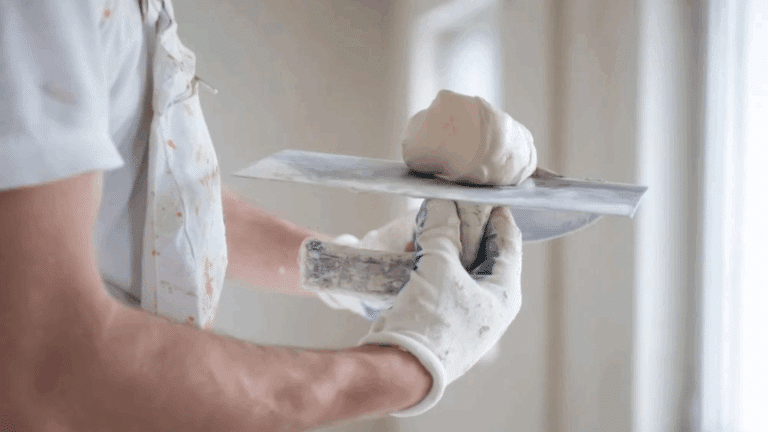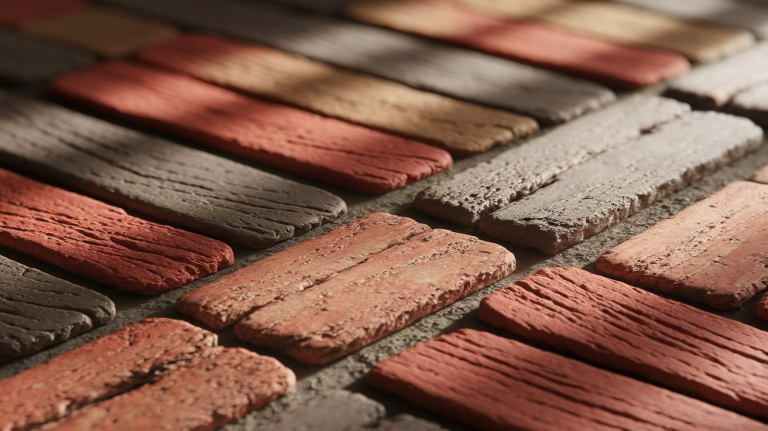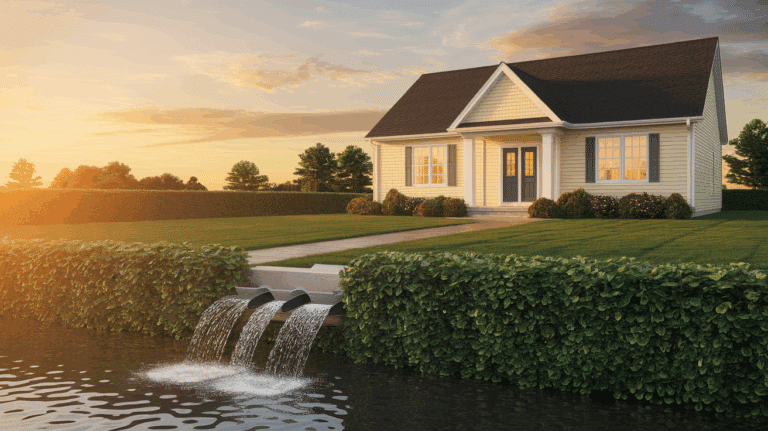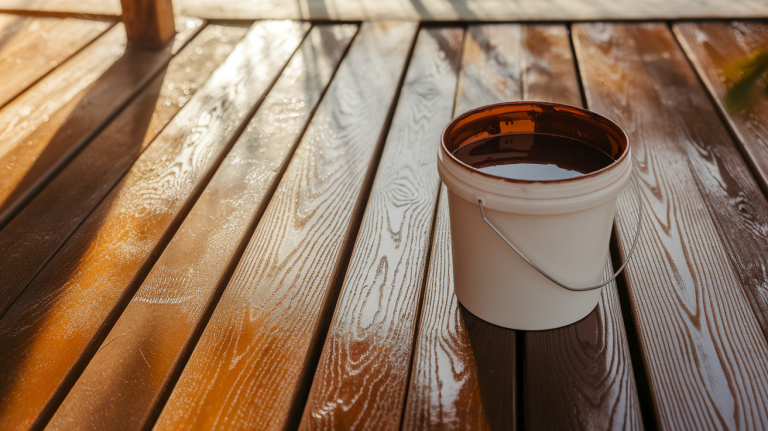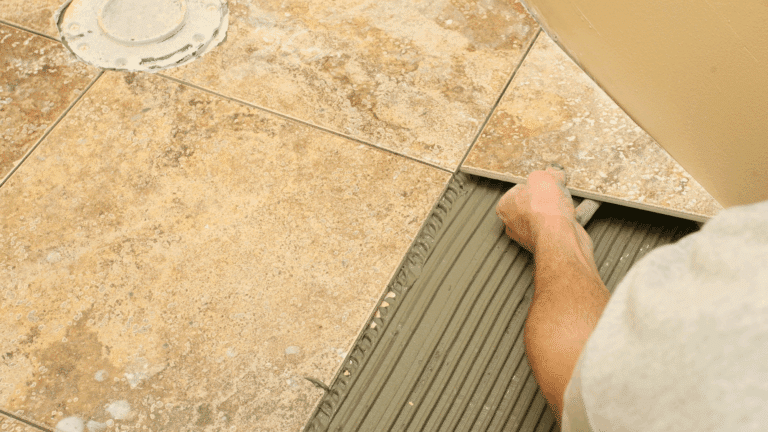Mixing Brick and Stone Exterior: Planning Guide and Ideas
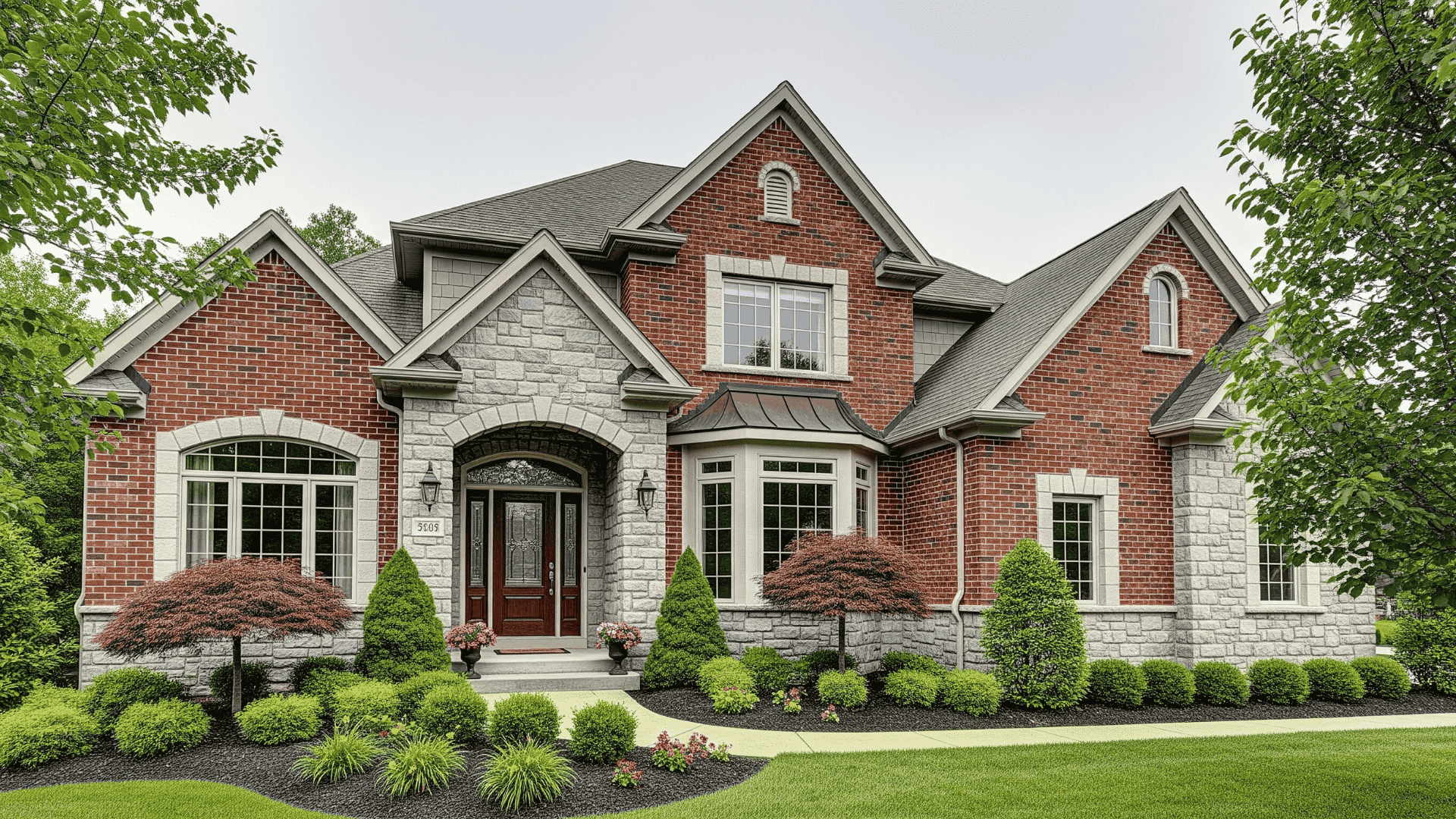
Mixing brick and stone on your home’s exterior creates a striking visual impact that can set your property apart.
These two classic materials bring different textures, colors, and characteristics that work together to form a unique look. Plus, you can mix and match styles to fit your personal taste.
This combination isn’t just about looks; it offers practical benefits, too. The durability of both materials means less upkeep and more protection from the weather.
In this blog, we’ll show you effective ways to blend brick and stone, share design tips, and help you find the right balance for your home’s style and your neighborhood setting.
Tips for Creating Mixed Brick and Stone Exteriors
Here are some practical tips to help you create a beautiful mixed brick and stone exterior that uplifts your home’s curb appeal.
- Choose Compatible Colors: Select brick and stone colors that complement each other and align with your home’s overall style. The tones should work together without competing visually.
- Balance Your Materials: Use one material as the primary element (about 70-80% of the exterior) and the second as an accent. This creates a visual hierarchy and prevents a chaotic appearance.
- Create Thoughtful Transitions: Plan where materials meet at logical architectural points such as corners, columns, or entryways. Avoid arbitrary changes in material that can look disjointed.
- Maintain Consistent Mortar: Use similar mortar colors and joint styles between your brick and stone areas to create unity across different materials.
- Consider Long-term Aging: Account for how different materials weather over time. Some stones may darken or change color differently than bricks, potentially affecting your design years later.
- Plan for Material Junctions: Pay special attention to how materials connect at meeting points. These junctions need proper flashing and sealing to prevent moisture issues and ensure durability.
Brick and Stone Exterior Combinations
Combining brick and stone creates visually striking exteriors that blend durability with timeless appeal. These material pairings offer vast design possibilities while maximizing structural performance and weather resistance.
1. Colonial Homes with Mixed Materials
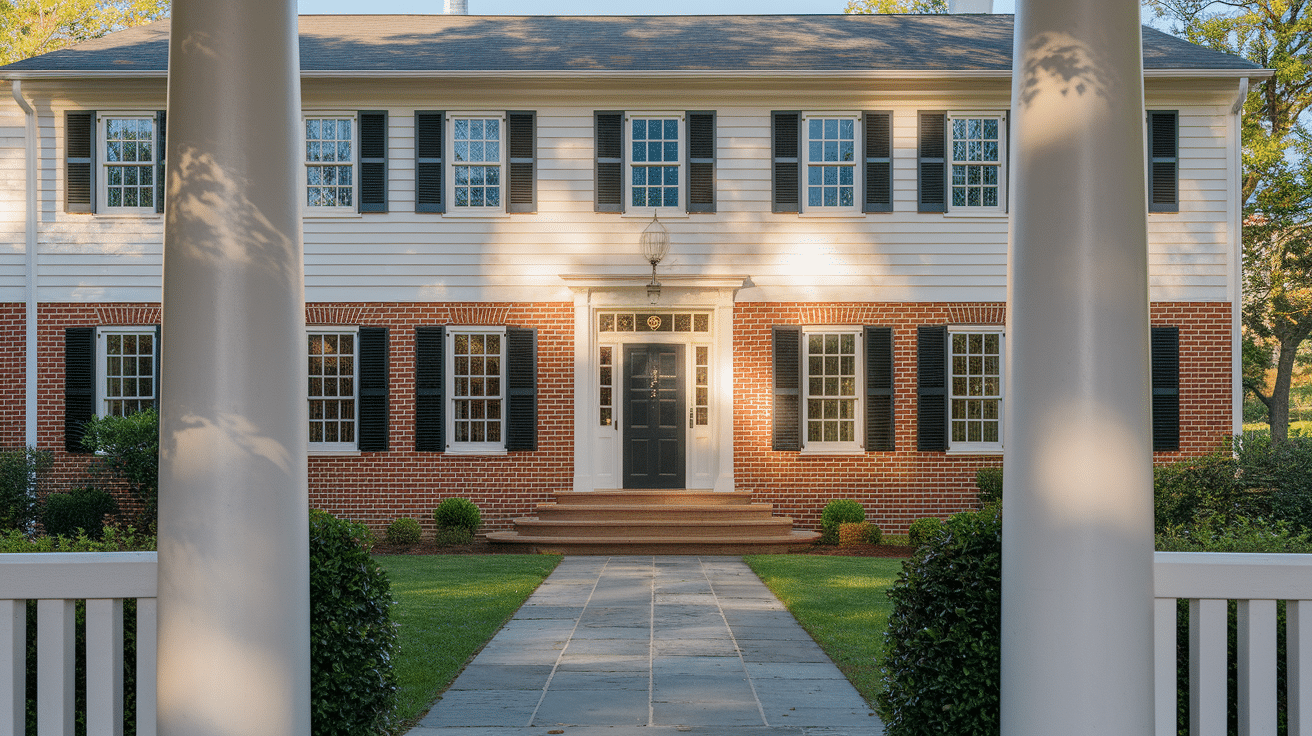
These homes combine brick, wood, and stone in traditional colonial structures. The balance of textures creates visual interest while maintaining historical accuracy.
The bold contrast between light-colored stone foundations and red brick walls gives these homes a strong visual base.
Other Colour Suggestions: Forest Green, Mustard Yellow, Ivory
2. Traditional Tudor Revival

A stone foundation with red brick walls creates a sense of permanence. Decorative stonework around doorways adds historical character to these stately homes.
Cross-timbering contrasts with masonry, showing craftsmanship. The combination makes these homes instantly recognizable in any neighborhood context.
Colour Suggestion: Forest Green, Antique Gold, Soft Ivory
3. Contemporary Contrast Facade
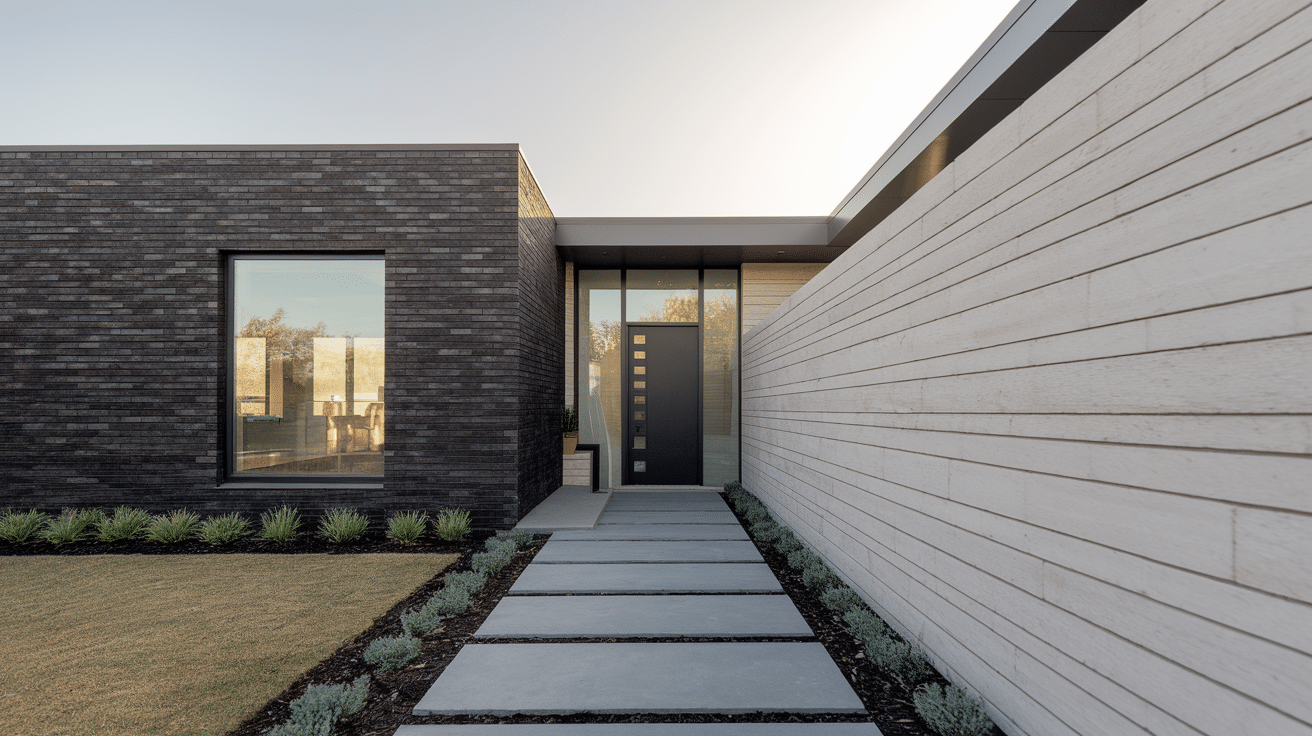
Smooth light stone paired with dark clinker brick creates dramatic visual tension. The contrast highlights architectural features without additional ornamentation.
Large-format stone slabs against textured brick sections create depth. This modern approach respects traditional materials while creating fresh compositions.
Colour Suggestion: Deep Aubergine, Brushed Copper, Dove Gray
4. French Country Provincial
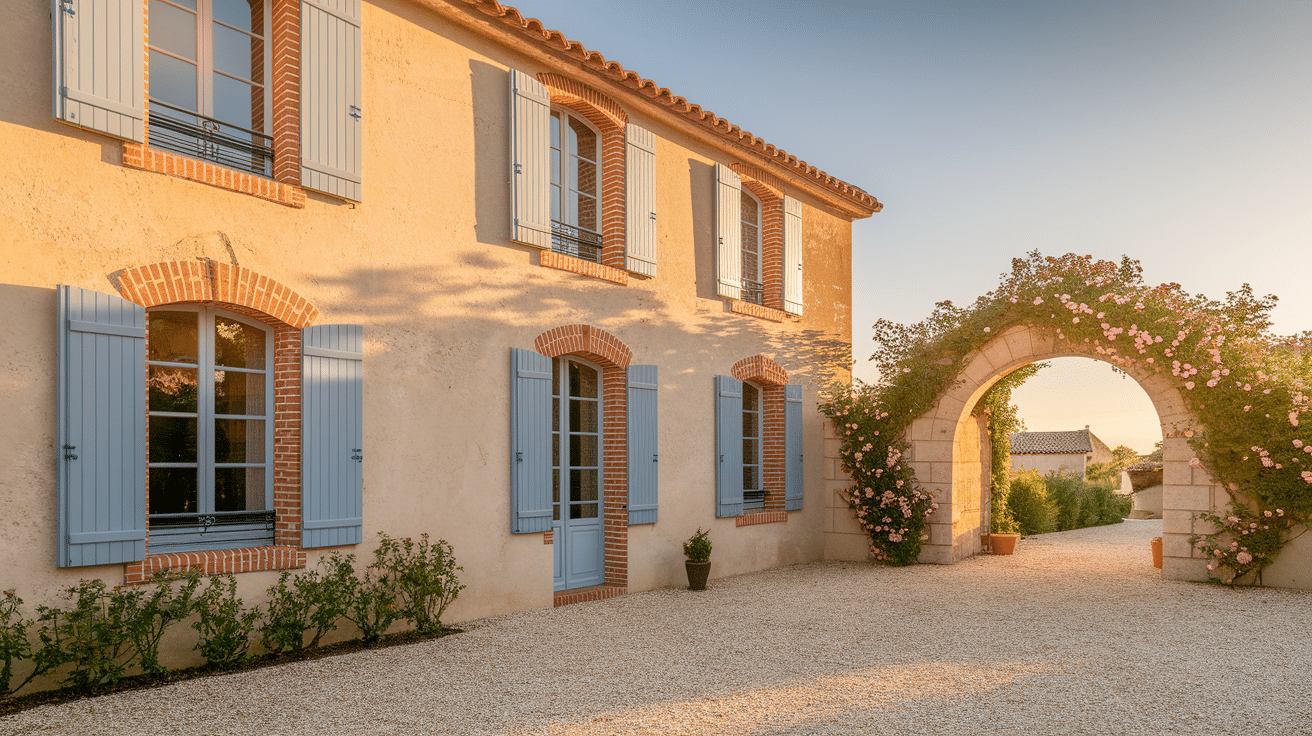
Irregular stone patterns with weathered brick accents mimic centuries-old European estates. The seemingly random arrangement creates a sense of time-worn beauty.
Rounded stone archways frame wooden doors and windows. Brick details add warmth to the cool stone foundation in these romantic structures.
Colour Suggestion: Dusty Blue, Rustic Clay, Pale Olive
5. Southwest Mission Style

Adobe-like brick combined with rough-cut stone creates a distinctive regional character. The textural difference between smooth brick and rugged stone surfaces adds visual interest.
Curved corners and straight lines play against each other. This design draws from Spanish colonial influences while adapting to modern structural needs.
Colour Suggestion: Deep Turquoise, Terracotta Brown, Muted Marigold
6. Mid-Century Modern Blend
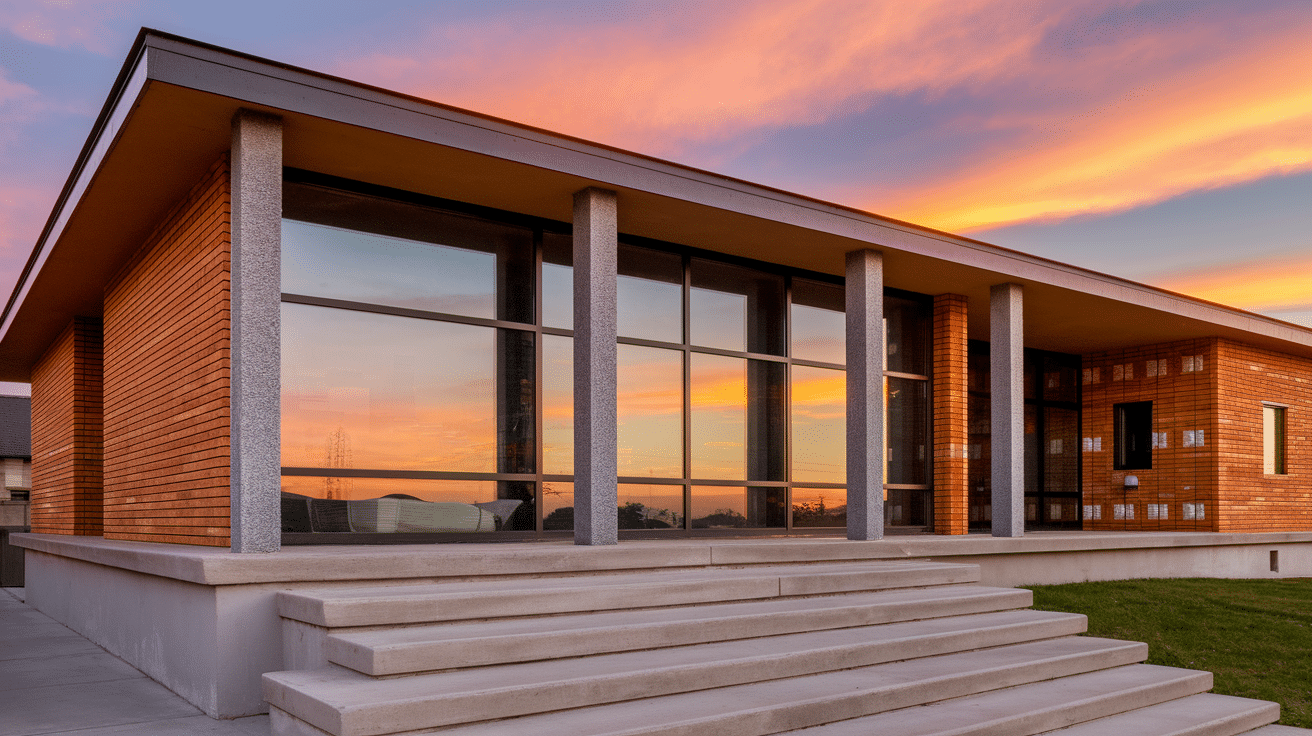
Horizontal brick courses contrast with vertical stone columns. This approach emphasizes geometry while maintaining the warmth of natural materials.
Cantilevered sections supported by stone create visual drama. The mix of materials supports the indoor-outdoor connection central to this style.
Colour Suggestion: Burnt Orange, Mint Green, Coffee Brown
7. Gothic-Inspired Modern
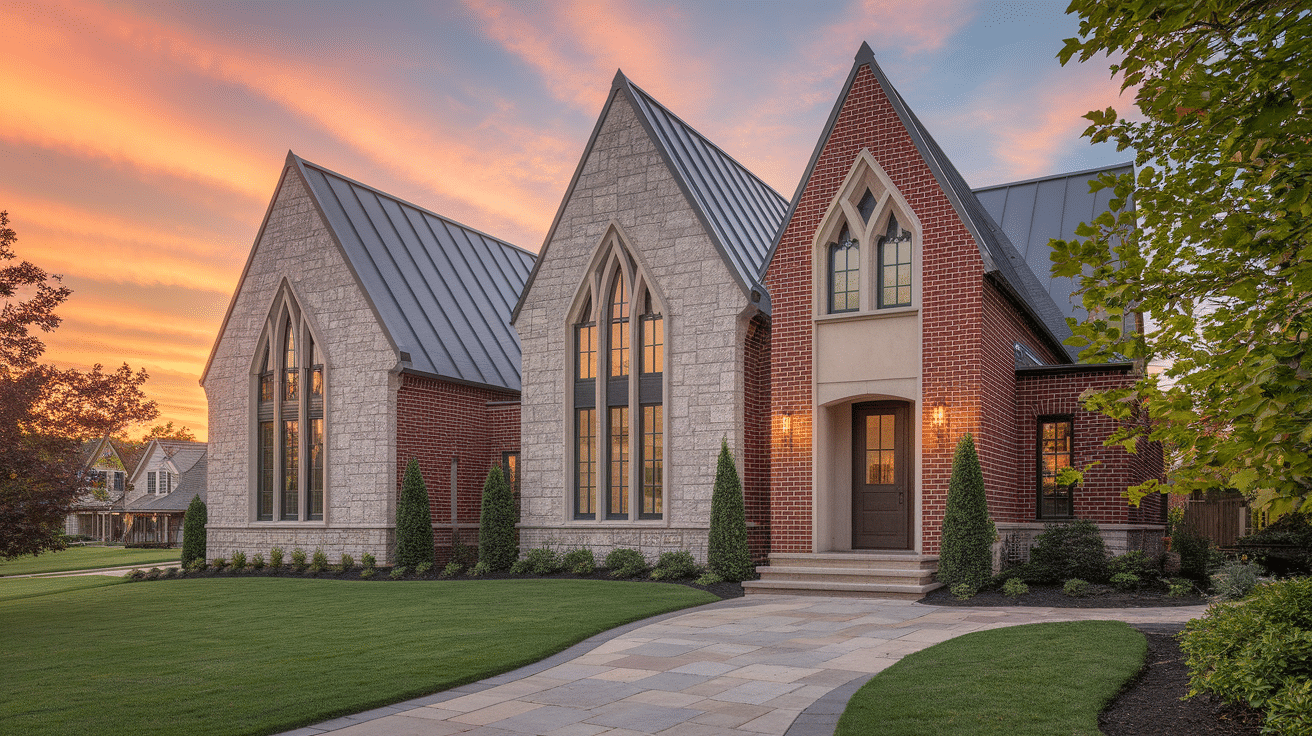
Sharp stone peaks contrast with smooth brick facades for a haunted effect. The vertical emphasis creates striking silhouettes against any skyline.
Detailed stonework frames minimal brick sections in this contemporary take. Traditional masonry techniques meet modern proportions in this bold structural statement.
Colour Suggestion: Mulberry Purple, Antique Brass, Silver Gray
8. Mediterranean-Asian Fusion
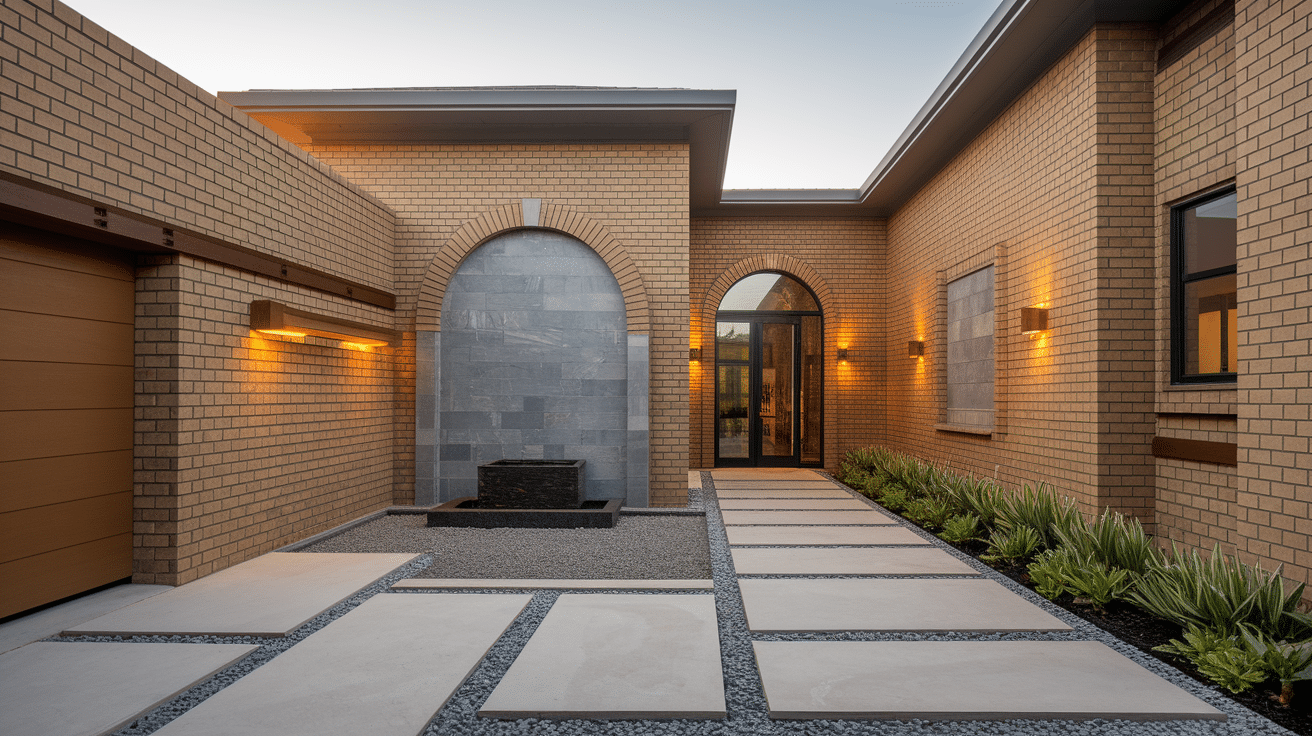
Stone courtyard walls paired with brick living spaces create defined outdoor rooms. The combination brings structure while maintaining flow between interior and exterior areas.
Flat stone caps top rounded brick archways in this cross-cultural blend. Asian minimalism meets Mediterranean warmth in the thoughtful use of complementary materials.
Colour Suggestion: Jade Green, Terracotta Pink, Golden Honey
9. Industrial Heritage Renovation
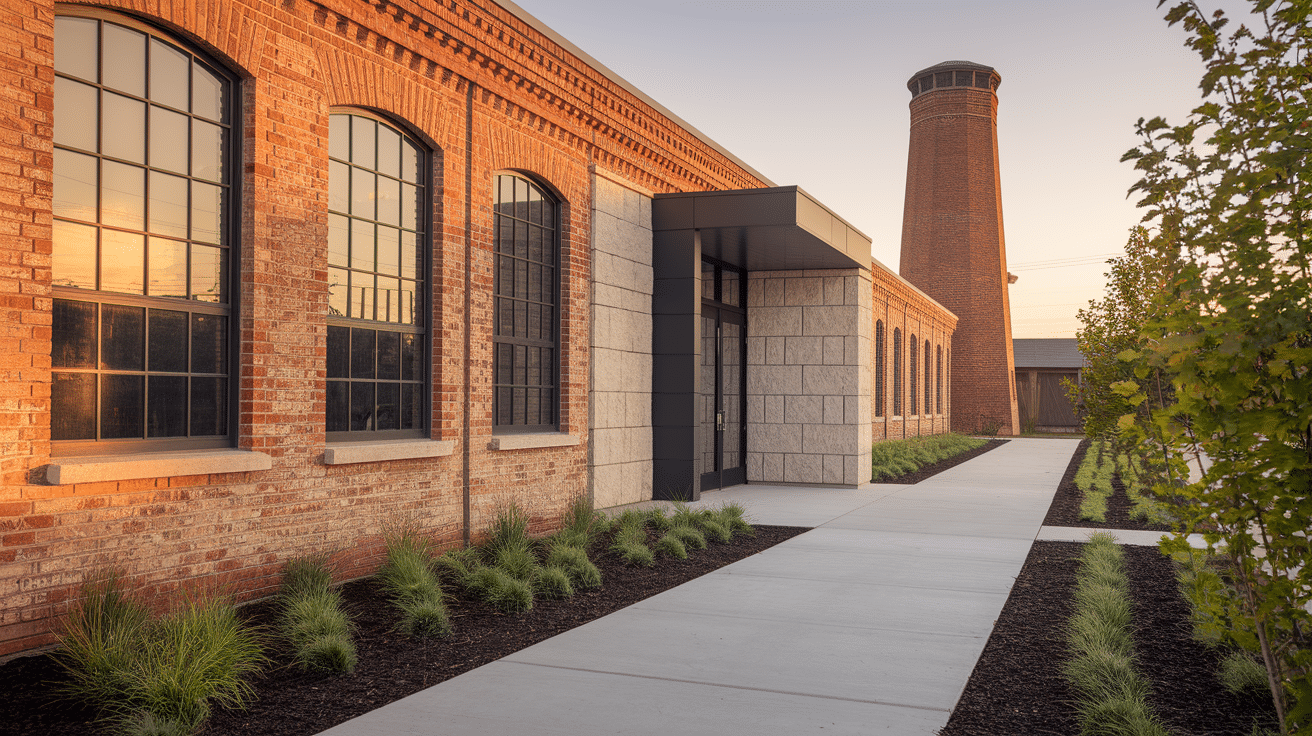
Reclaimed factory brick paired with new-cut stone creates a dialogue between the past and present. This approach honors history while adding contemporary elements.
Original brick details are preserved alongside clean stone additions. The contrast highlights both the patina of age and the precision of new construction.
Colour Suggestion: Teal Blue, Weathered Bronze, Charcoal Gray
10. Scandinavian-Influenced Minimalism
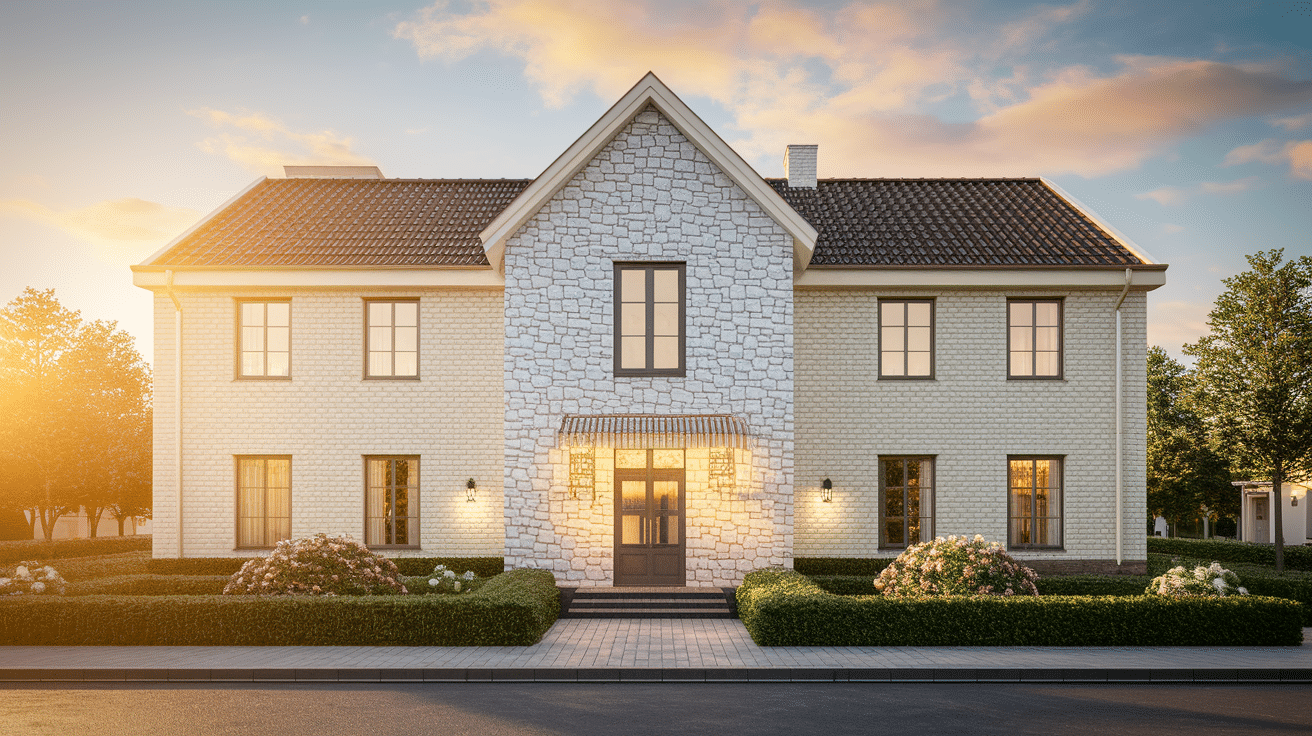
Pale brick in simple patterns paired with light cut stone creates subtle texture variation. This restrained approach focuses on quality materials rather than ornamentation.
Clean lines and minimal detailing emphasize material beauty. The light-colored materials maximize sunlight reflection during short winter days.
Colour Suggestion: Smoky Plum, Warm Taupe, Matte Black
Comparison with Other Materials
Here’s a detailed comparison of various flooring materials, highlighting their initial costs and other factors to help you make an informed decision.
Cost Comparision
| MATERIAL TYPE |
INITIAL COST(PER SQ FT) |
LONG-TERM VALUE |
|---|---|---|
| Stone | $10-$30 | Lifetime material with proper sealing and care; minimal fading |
| Concrete | $5-$10 | High resistance to wear, minimal upkeep, 30+ year lifespan |
| Ceramic Tile | $3-$25 | Excellent durability, occasional grout maintenance, 20+ year lifespan |
| Hardwood | $8-$25 | Can last 25+ years with proper care; can be refinished multiple times |
| Laminate | $1-$7 | 7-15 year lifespan; cannot be refinished; good moisture resistance |
| Vinyl | $1-$5 | 10-20 year lifespan; simple upkeep; excellent water resistance |
| Bamboo | $5-$13 | 10-25 years with proper maintenance; can be scratched by pets |
| Cork | $3-$12 | 10-15 year lifespan; can be affected by moisture; comfortable underfoot |
Additional Considerations:
It’s essential to factor in these considerations when choosing materials to ensure a cost-effective, durable, and suitable solution for your space.
- Installation Complexity: Some materials require specialized tools and skills, increasing labor costs.
- Regional Variations: Costs may differ based on your location and local supply availability.
- Maintenance Expenses: Factor in cleaning products, periodic treatments, and replacement costs.
- Climate Impact: Materials perform differently in various humidity and temperature conditions.
- Subfloor Requirements: Some options need specific base preparation, which may add costs.
Considering these factors early helps balance investment, performance, and maintenance in decision-making.
That’s a Wrap
Mixing brick and stone on your home’s exterior is like creating a custom suit; it fits just right and makes you look good. These materials work as a team to give your house character while standing strong against rain, snow, and time.
Not sure where to start?
Try adding stone around your front door or brick on lower walls. You can always add more as your confidence grows.
Pick colors that make sense together, think about how they’ll meet, and consider how sun and rain will change them over time.
Your home tells your story, and a smart mix of brick and stone helps it tell that story with style and strength.

